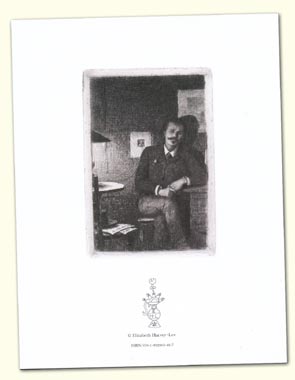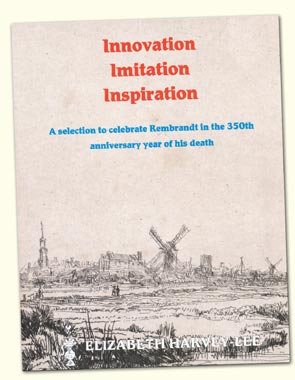|
INNOVATION; IMITATION; INSPIRATION
A selection to celebrate Rembrandt
in the 350th anniversary year of his death
“So what Rembrandt alone, or almost alone, has among painters, that tenderness…
that heartbroken tenderness, that glimpse of the superhuman infinite …”
Van Gogh in a letter to his brother Theo on 2 July 1889
Much earlier, in 1686, Filippo Baldinucci in Florence, praised Rembrandt’s
“highly bizarre technique , which he invented for etching and which was his alone,
being neither used by others or seen elsewhere. This he achieved by using lines
of varying lengths and irregular strokes … to create a strong chiaroscuro
of painterly appearance.”
Rembrandt died 350 years ago, and 2019 has been marked by some delightful exhibitions in his honour, in Amsterdam*, Edinburgh*, Dulwich* and (next year) Oxford.
 |
|
Back cover, showing a
Self-Portrait by Candlelight
by Evert van Muyden. |
|
It is an anniversary which as a print dealer I cannot ignore.
Rembrandt is the painter-etcher. He produced roughly the same number of etchings as paintings, a much higher percentage of his oeuvre, than any other major painter who was also an important etcher. They contribute equally to his reputation; though to my mind he was a graphic artist par excellence. And to 18th & 19th century admirers he was first and foremost an etcher.
His plates have a huge variety of subject matter, more than any other single etcher, and in his prints he treats some motifs which do not appear in his paintings.
Rembrandt etched self-portraits, portraits, religious subjects, oriental costume, classical themes, scenes from everyday life, nudes, erotica, the artist at work in the studio, interiors, animals, allegory, a still life, a seascape and landscapes. Only urban topography did not seem to have interested him as an artist.
Technically and stylistically too Rembrandt was innovative and various, in the spontaneous freedom of his linear etching, his exploiting the richness of drypoint as an independent technique, hatching to create the drama of chiaroscuro and the expressive possibilities of light in darkness, in making striking compositional changes to some plates in a series of different states.
He was the first to explore the effect of using different papers to print on, whether soft ‘white’ laid ‘Holland’ paper, golden japan, grey or beige oatmeal, vellum, or tinted papers.
After a hugely successful start to his career, Rembrandt became less fashionable in his later years in Amsterdam and died in poverty.
After his bankruptcy and move from the Breestraat to the Rozengracht he no longer had an etching press.
He was ‘rediscovered’ in the rest of Europe through the 18th and 19th centuries, influencing many etchers, particularly in Britain and Germany.
While I am sadly not in a position to be able to offer a wide range of Rembrandt’s own etchings, I have had fun finding related works, so that the first section of this catalogue is devoted to his work; to that of some of his peers and pupils; to his followers and copyists; and to some of his themes. (The second, unrelated, section of the catalogue simply has a selection of various prints.)
The ‘decorations’ in the Introduction are from Rembrandts I have handled in the past.
REMBRANDT HARMENSZ. VAN RIJN
Leiden 1606 – 1669 Amsterdam
St Jerome, either in prayer in the ‘wilderness’ or studying or writing his translation of the Bible from Greek into the Latin vulgate, was a subject that Rembrandt obviously found sympathetic. He painted the saint a number of times and made seven etchings on the theme. Of his other plates representing saints he etched only a single plate of St Francis, a single plate of St Stephen, a single plate of St John the Baptist, and three of the Apostles Peter & John.
St Jerome in a Dark Chamber
New Hollstein 212 ii-iii/iii; Bartsch 105 ,Hind 201 ii/ii
150 x 168 mm (sheet)
Original etching, 1642, the plate signed and dated at the lower edge.
A later impression, darkly printed, on laid paper. Trimmed to the plate at the top and foot; and fractionally into the subject at the sides. £2800
Ex collection Audrey Gibbs
Rembrandt quite frequently portrayed a single figure in an interior dimly lit by a single window, though no others show an interior so extremely dark that many of the details are obscured. In this impression they are mainly only to be seen from the reverse when the sheet is held up to the light. Such is the case with the usual iconographical ‘attributes’ that identify St Jerome: the cardinal’s hat (hanging to the right of the staircase); the skull (on a ledge at the back of the room); his lion (added at Jerome’s feet in the second state); only the crucifix directly in front of the window can be easily made out.
The composition of the cogitating saint seated near the window in a room with a winding spiral staircase is closely related, in reverse, to a painting in the Louvre, attributed to Rembrandt (with a signature and date of 1632) known as the Philosopher in Meditation (but thought actually to represent Tobit and his wife awaiting the return of their son Tobias)
* Some interesting reading:
- Simon Schama: Rembrandt’s Eyes. 1999, Penguin.
- Anthony Bailey: Rembrandt’s House. The World of the Master. 1978, Dent.
- Dulwich Picture Gallery exhibition catalogue: Rembrandt’s Light. 2019, various authors.
- Museum Het Rembrandthuis exhibition catalogue: Rembrandt’s Social network. Family,
Friends & Acquaintances. 2019, various authors.
- National Galleries Scotland exhibition catalogue: Rembrandt Britain’s discovery of the
Master, 2018, various authors.
- Museum Het Rembrandthuis – Studies from the Rembrandt Information Centre (Vol.1) Rembrandt & his Influence on Eighteenth Century German & Austrian Printmakers.
1998, Liesbeth Heenk.
- Peter Hecht: Vincent Van Gogh and Rembrandt. 2006, The Van Gogh Museum.
- Jonathan Bikker: Rembrandt:Biography of a Rebel. 2019, published to accompany the
Rijksmuseum exhibition, All the Rembrandts.
- Prado exhibition catalogue (only in Spanish):Velásquez, Rembrandt, Vermeer. Parallel
visions. 2019
Published December 2019.
Quarto paperback; 80 pages, 150 items offered for sale, all illustrated
(Price U. K. £12; Overseas £20)
Prints available
Prints from this catalogue are still available.
^ Return to the top of this page ^ |
|

Front cover, showing detail from View of Amsterdam, from the North-West, a copy of Rembrandt’s etching by Cecilia Lucy Brightwell.
Artists
included in the catalogue:
- Aynscomb M
- Baillie W
- Bauer M
- Benenson L C
- Blackburn C
- Bone M
- Boreel W
- Brightwell L
- Brockhurst G L
- Brouet A
- Cadzow J
- Castiglione G B
- Chambars T
- Chamberlain S
- Cheston C S
- Clilverd G B
- Cotman J S
- Cotman M E
- Crome J
- Daniell E T
- Daubigny C F
- Delarum F
- Denyer-Baker B
- Dodd F
- Dorner J J
- Douw G
- Dürer A
- Earthrowl E G
- Eimmart G C
- Elsheimer A
- Gainsborough T
- Geddes A
- Gibbings R
- Gorlato B
- Goya F
- Guérard H
- Haden S
- Harvey H J
- Hayter G
- Hitchcock S M
- Hodgson D
- Holmes K
- Homan R
- Hunt W Howes
- Jefferies K G
- Kubin A
- Lawrence E
- Lievens J
- Livens H
- Lound T
- Lutma J
- Marvy L
- Mathiesen J G
- McBey J
- Meidner L
- Menpes M
- Middleton J
- Milnes W H
- Morris M
- Müller F (M)
- Narbeth W
- Nasyth A
- Neuberger D
- Ninham H
- Osbourne M
- Pankok B
- Passe M van de
- Pellew C
- Power J P
- Pontius P
- Quellinus E
- Ray-Jones R
- Read D C
- Rembrandt
- Rembrandt after
- Robins W P
- Schalken G
- Schut C
- Short F
- Stannard J
- Strang W
- Sturges D C
- Thornhill J
- Unsin F S
- Van Dyck A
- Van Muyden E V
- Van Vliet J J
- Walcot W
- Ward T W
- Webb C
- Wilson B
- Winkler J W J
- Wolf F X
- Worlidge T
- Worsip J
- Zorn A
Return to the top ^
|